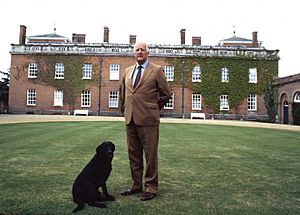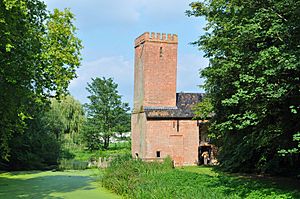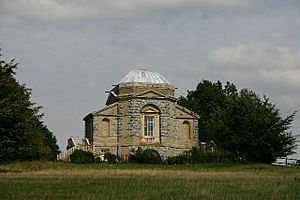Euston Hall facts for kids
Quick facts for kids Euston Hall |
|
|---|---|

The 11th Duke of Grafton in front of Euston Hall
|
|
| General information | |
| Location | Euston, Suffolk |
| Country | England |
| Coordinates | 52°22′24″N 0°47′12″E / 52.37345°N 0.78676°E |
| Construction started | 1666 |
| Completed | 1904 |
| Owner | Henry FitzRoy, 12th Duke of Grafton |
Euston Hall is a beautiful old country house located in a small village called Euston, in Suffolk, England. It's famous for its amazing park, which was designed by two very well-known landscape artists, William Kent and Capability Brown. This grand house has been the family home of the Dukes of Grafton for many years.
Contents
History of Euston Hall
Early Beginnings
Euston Hall has a long history, first appearing in a very old record called the Domesday Book in 1086. Back then, it was a manor (a large estate) that belonged to an abbey.
In August 1578, Queen Elizabeth I even stayed at the manor hall! She was on her way to Norwich and visited the Rookwood family who owned the estate at the time.
Building the Grand House
The estate was bought in 1666 by Henry Bennet, who was the Earl of Arlington. He was an important person, working as Secretary of State for King Charles II.
Henry Bennet built a magnificent new house in the French style. It had a central courtyard and large buildings at each corner. King Charles II visited Euston several times, starting in 1671.
Royal Connections and Changes
In 1672, King Charles II arranged a marriage between his young son, Henry FitzRoy, and Isabella Bennet. Henry was nine and Isabella was five. Henry later became the 1st Duke of Grafton in 1675. They had a second wedding ceremony in 1679 when Isabella was old enough.
The Duke and Duchess inherited Euston Hall in 1685. Around 1750, their son, the 2nd Duke, decided to update the house. He hired Matthew Brettingham to help with the changes. The house's domes were replaced with the low, pyramid-shaped roofs you see today.
Fire and Rebuilding
Sadly, on April 5, 1902, a big fire destroyed parts of the house, including the south and west wings. The house was rebuilt quickly, following the same design. However, in 1952, the 10th Duke decided to remove the south wing and most of the west wing.
Art and Famous Connections
Euston Hall has a wonderful collection of art. One painting by Canaletto is very special. It shows Westminster Bridge in London being built. The 2nd Duke of Grafton helped make this bridge happen because he wanted an easier way to cross the River Thames!
The estate is also famous because it gave its name to Euston railway station in London. The Dukes of Grafton owned the land where the station was built and supported its development.
The Beautiful Park
Early Designs
The park at Euston Hall is just as impressive as the house. The original park was designed by John Evelyn, who was a diarist and an expert on trees and landscapes. He created canals, straight paths, and tree-lined avenues. His designs for the pleasure grounds can still be enjoyed today.
In 1738, William Kent designed the entire park and river layout. His work at Euston is considered one of his greatest achievements. You can still see his temple and entrance archway today.
Capability Brown's Influence
Capability Brown, another very famous landscape designer, worked at Euston from 1776 until he passed away in 1783. He improved the water features for the 3rd Duke of Grafton. He made Kent's small lakes and streams into a large new lake called Broadwater, which has a central island. This lake was designed to offer beautiful views of the house through the trees.
Brown also built a weir to guide water from the River Blackbourne into the lake. He likely shaped the riverbank in front of Euston Hall and planted trees near the lodges on the western side of the estate.
Special Features in the Park
- Euston Watermill: This watermill was built in the 1670s to help with irrigation and grinding corn. In 1731, William Kent redesigned it to look like a church! Later, in 1859, an iron waterwheel was added by Charles Burrell.
- The Temple: This is a unique octagonal building designed by William Kent in 1746. It was his last work. It's a type of "folly" (a building built just for decoration) and has a magnificent octagonal banqueting hall with a dome. The Temple is not open to the public.
Today, the house and grounds include about 110 acres of parkland and 65 acres of pleasure grounds. The landscaping had a big restoration project before the Capability Brown tercentenary in 2016, making sure it looks its best.



